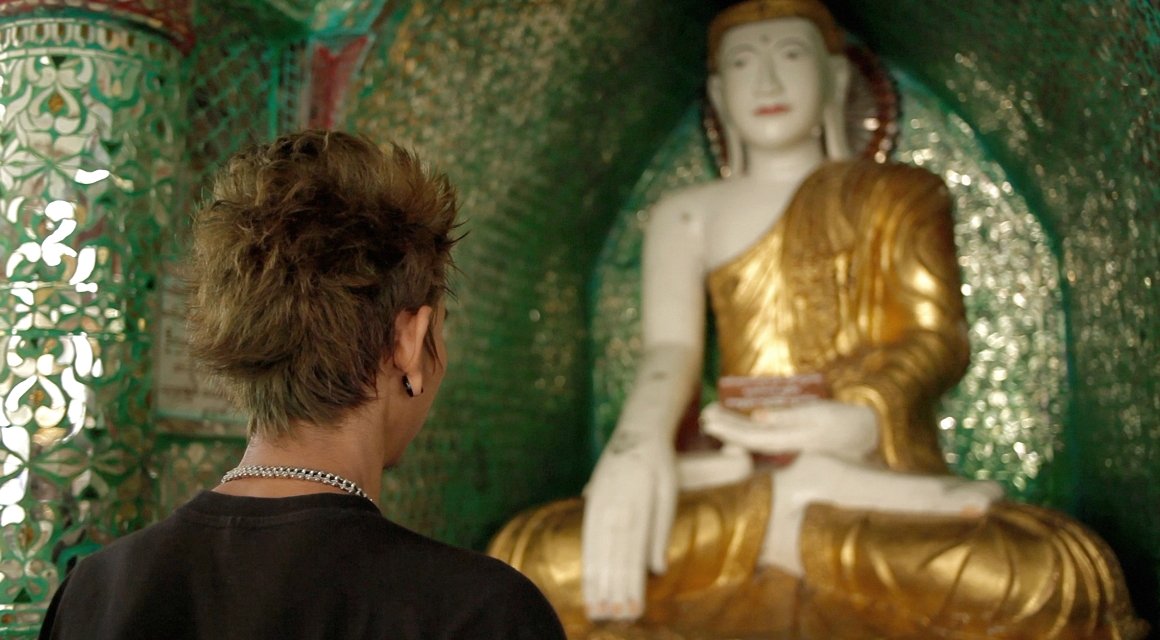On Monday, February 21, “My Buddha is Punk,” an Andreas Hartmann production, will be shown at 6 pm in Carnegie 010 at St. Lawrence University. The film highlights the journey of a young Burmese punk and his peers in their incredible quest to create a peaceful and just system in Myanmar. The film screening and the photo exhibition at the Richard F. Brush Art Gallery titled “Storm: The Fight for Democracy in Myanmar and the Diaspora” is a demonstration of the SLU community’s ongoing commitment in bringing attention to the situation in Myanmar.
Jordan Pescrillo ’12, a former SLU Minmahaw Fellow and currently working in non-profit post-secondary education in Myanmar says, “We have been able to put together awareness events since 2021 to encourage the international community to learn about what’s happening in Myanmar and to find ways to support.” She adds that the film screening is another event carefully planned and catered to SLU students and general North Country community members, to sustain attention and awareness about Myanmar.
The screening would not have been possible without the initiative of Tsewang Lama, Coordinator of International Student Services. Along with the movie, she also helped facilitate the photo exhibition in the Richard F. Brush Art Gallery. “As of August 2021, more than 1,000 Burmese civilians have been killed, but it has not gotten much media coverage,” she says. “It is crucial that we continue to highlight this crisis. Organizing events at a grassroot level is one way in which we can support the people of Myanmar during this dark period.” Her experience of working with Burmese refugees resettled in the US in Buffalo, NY, whose lives are reflected in the photo exhibition, is at the core of her dedication to this cause.
Catherine (Cathy) Tedford, director of the Gallery, delights in this fruitful collaboration between staff members, SLU alum, and photographers across the globe. She notes, “The Gallery often collaborates with faculty, staff, students, and alumni on such projects, especially if the projects dovetail with the SLU liberal arts curricula.” The exhibition has also prompted SLU students to think critically about personal freedom, government structure and effectiveness, as well as social movements sponsored by the young, according to Tedford.
One crucial aspect of these awareness-raising events is the ability for visual images or film to efficiently deliver the intricacy of social movements. Patrick Htoo, a photographer currently based in Yangon, Myanmar, and one of the two featured artists in the exhibition, speaks to the power of visual communication. “Especially during the protests, photos and videos showed how they (the military) took down the protesters, how many they brutally arrested and killed that time,” he said. “Visual storytelling allows people around the world to see what is actually happening in Myanmar day by day without imagining.”
Pescrillo agrees with Htoo. She adds, “Myanmar artists are masters of hidden messages in their work due to decades of censorship and oppression. Some of the photos and especially the film show the breaks in censorship that occurred during the quasi-democracy period and the risks current artists are taking to highlight the people’s will to get their power back.”
For Tedford, seeing visual documentation makes the struggle much more real. “The people represented in Patrick Htoo’s photos are just like you and me in some ways – wanting to live in a free and open society, wanting to make the world a better place for themselves and their loved ones,” she said. “Likewise, seeing the images of Burmese immigrants in Buffalo trying to make new lives for themselves in such a new environment made me feel a deep sense of empathy for their situation.” Law Eh Soe’s photographs center around telling the story of Burmese people in his two worlds: one world rooted in the beauty and unrest of his homeland and the other looking towards the future as people rebuild their lives as new Americans in the US.
These emotions that Tedford experiences, according to Tsewang Lama, are the testaments to what the film and exhibition is all about: showing the trials and tribulations of being a young democracy, the strength and determination with which its people are fighting to keep their ideals alive, and making people feel it along the way.
Finally, Pescrillo expresses that the support need not stop at film screening attendance, “Continue to advocate for the Burma Bill, keep #whatshappeninginmyanmar story alive internationally, donate in any way you can to the cause, and keep on educating yourself about Myanmar and the current situation.” Support can also be given to non-profit organizations like International Institute of Buffalo that provide needed services to refugees who are resettled in the US.
More information on the cause can be found through here.
The film screening will be on Monday, February 21, at 6pm in Carnegie 010. It is free and open to the public. Masks are required of all individuals attending in person per the University’s COVID-19 policies. Fifty percent of the licensing fee to screen the film will be donated to Food Not Bombs Myanmar. The “Storm: The Fight for Democracy in Myanmar & the Diaspora” exhibition will continue till February 26 in the Richard F. Brush Art Gallery.



